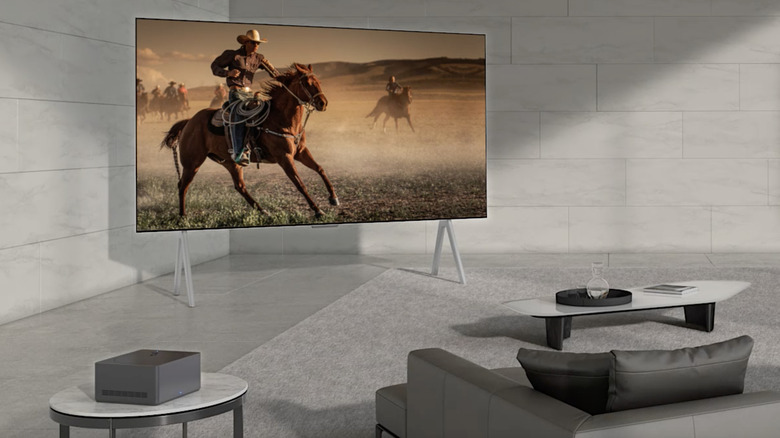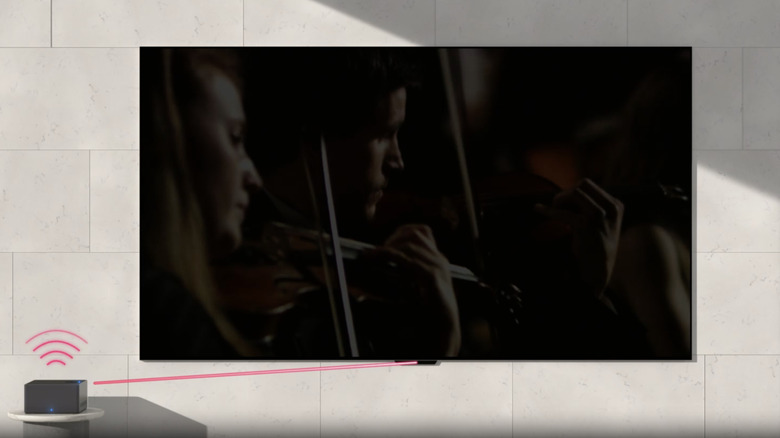How Do Wireless TVs Work, And Are They Worth The Cost?
For many people with home entertainment centers, cables have become the bane of their existence. Keeping those unwieldy cables for multiple devices in check can sometimes feel like a full-time job. However, you have to do it because all of these devices need to be plugged into your TV to work. From gaming consoles to media players, cables connected to TVs abound in most living rooms across the country. While we may not like it, we've come to accept the status quo. Even as wireless technology has become commonplace, the TV has remained firmly in the cabled domain, at least until now.
A couple of enterprising TV manufacturers — LG and Displace TV — are looking to change things up, which means TVs are joining the long list of devices that use wireless technology to help people untangle their lives. Just like you can enjoy a cable-free experience listening to your favorite tunes with the best Bluetooth headphones or use a wireless keyboard to declutter your desk and type without being tethered to your computer, wireless TVs are promising to usher in a new era of TVs without a bunch of tangled wires
How do wireless TVs work?
With LG's wireless TV, the only cable you'll need is the power cord. Beyond that, it's designed to operate without the traditional cables needed to transmit video and audio signals from external devices. The Displace TV is powered by two internal lithium-ion batteries and four hot-swappable lithium-ion batteries, eliminating the need for cables entirely. These batteries can power the TV for up to 180 hours when fully charged.
LG's wireless TV uses Zero Connect technology to transmit 4K video and audio to its Signature OLED M TVs wirelessly. The TV comes with a Zero Connect Box (which also needs a power cable to work) that operates independently, so you can place it where you'd like within a 30-foot range of the TV. This wireless AV box comes with several connection points, including HDMI 2.1, USB, RF, LAN, and Bluetooth. From streaming devices like the Fire TV Stick 4K Max to gaming consoles, users can plug almost any type of device into the Zero Connect Box.
From there, an algorithm identifies the best transmission path to transfer the data from the box to the TV while minimizing errors from environmental changes. For example, if it detects movement in a room, like a child playing or a dog running around, it can use an alternate path to maintain a consistent connection. While there's not as much information available about how the Displace TV works, like LG, it uses a base unit plugged into a wall outlet to send audio and video to the TV wirelessly.
Are wireless TVs worth the cost?
As with any new technology, these wireless TVs aren't cheap. At one point, the going price for the 97-inch version of LG's Signature OLED M wireless TV was a whopping $35,000. The prices have come down a bit, with the 97-inch model selling for $24,999.99, the 83-inch model for $6,999.99, and the 77-inch model for $4,999.99. As for the Displace TV, it's available in different packs that allow users to combine several 55-inch TVs together to make a bigger unit. One Displace TV and base control unit costs $4,499, a two-pack with two base control units costs $8,099, and a four-pack with four base control units costs $13,499.
When compared to the price of a traditional smart TV, wireless TVs are still quite a bit more expensive, depending on the model and size you purchase. The biggest benefit wireless TVs hold over their wired counterparts is aesthetics. A flat-screen TV looks a lot better hanging on a wall without a lot of wires snaking down from it to connect to different devices. Still, for the average person who needs to think about their budget, splurging on a wireless TV probably isn't worth it. If past technological trends hold, the prices of these TVs will likely drop in the next few years, making them more affordable.


